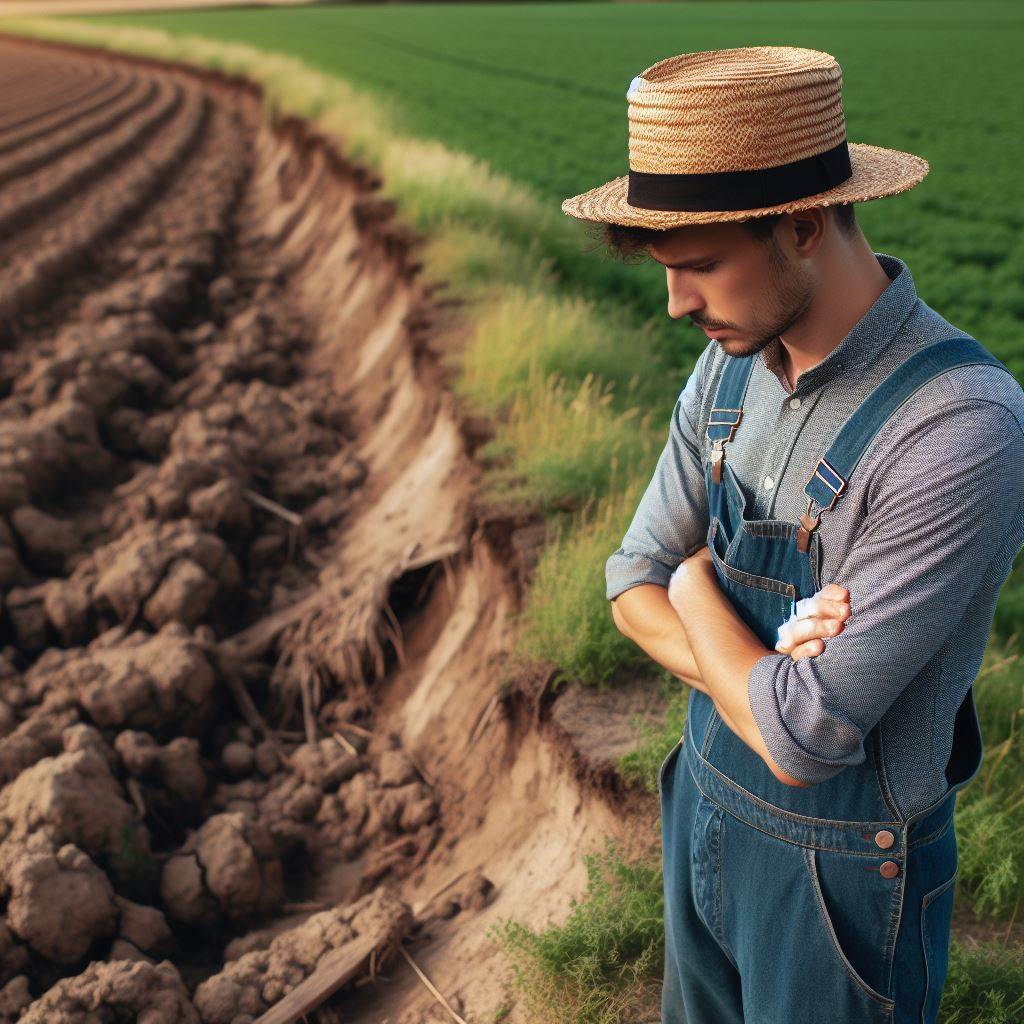Introduction
Importance of soil erosion prevention
Soil erosion is a major concern as it leads to loss of fertile topsoil, disrupting ecosystems.
Overview of natural methods to prevent soil erosion
Natural methods such as planting cover crops, contour plowing, terracing, and mulching can help prevent soil erosion.
Soil erosion is a serious environmental issue that affects not only agricultural productivity but also our overall ecosystem. Excessive erosion leads to the loss of fertile topsoil, which is crucial for plant growth and agriculture.
Additionally, it disrupts the balance of ecosystems, negatively impacting biodiversity.
To combat soil erosion, it is essential to adopt natural methods that promote soil conservation. These methods work in harmony with nature, ensuring sustainable land management practices and preserving the delicate balance of the environment.
One effective way to prevent soil erosion naturally is by planting cover crops. These crops, such as legumes, grasses, or clover, are grown primarily to protect the soil from erosion.
Their extensive root system helps bind the soil particles, reducing the risk of erosion caused by wind or water.
Contour plowing is another method widely used to prevent soil erosion. It involves plowing furrows across the slope, following the contour lines of the land. By doing so, runoff water is diverted along the contours, reducing its velocity and preventing soil erosion.
Terracing is yet another effective technique. It involves creating level platforms on slopes to prevent water from running downhill and taking away the valuable topsoil. This method is particularly useful in areas with steep slopes.
Mulching is an excellent practice that involves covering the soil with organic materials like straw, leaves, or wood chips. This protective layer acts as a barrier against erosion, reducing the impact of rainfall and wind.
Basically, preventing soil erosion is crucial for maintaining healthy ecosystems and sustaining agricultural productivity.
Utilizing natural methods like planting cover crops, contour plowing, terracing, and mulching can significantly contribute to soil conservation and ensure a sustainable future.
Understanding Soil Erosion
Definition and Causes of Soil Erosion
Soil erosion refers to the process of the detachment, transport, and loss of soil particles from the earth’s surface. It is typically caused by natural forces like wind, water, and ice or human activities such as deforestation and unsustainable farming practices.
Water erosion
Intense rainfall can cause the soil to become compacted and less porous.
The absence of vegetation to act as a natural shield increases the risk of water erosion.
When raindrops hit the soil directly, they dislodge particles and create runoff.
Wind erosion
Dry and loose soils are vulnerable to wind erosion.
Deforestation, overgrazing, and improper land management practices contribute to wind erosion.
High winds blow away the top layer of soil, leaving it infertile and prone to desertification.
Transform Your Agribusiness
Unlock your farm's potential with expert advice tailored to your needs. Get actionable steps that drive real results.
Get StartedIce erosion
Areas with freezing temperatures experience ice erosion, which occurs as a result of the expansion and contraction of water when it freezes.
The freezing and thawing cycles weaken the soil structure, making it susceptible to erosion.
Impact of Soil Erosion on Agriculture and the Environment
Soil erosion poses significant challenges to agriculture, natural ecosystems, and the environment as a whole.
Agricultural impact
Eroded soil loses essential nutrients, making it less fertile and reducing crop productivity.
Sediment runoff enters waterways, polluting them and harming aquatic life.
Farmers face increased costs due to additional fertilizers, irrigation, and soil restoration efforts.
Environmental impact
Soil erosion leads to the loss of valuable topsoil, which takes many years to replenish.
Degraded soil affects biodiversity and disrupts the balance of ecosystems.
The sedimentation of rivers and lakes can result in habitat destruction and loss of water resources.
Climate change impact
Eroded soil releases carbon dioxide into the atmosphere, contributing to greenhouse gas emissions.
Soil erosion reduces the soil’s ability to store water, exacerbating the effects of droughts and floods.
The loss of vegetation due to erosion reduces carbon sequestration and accelerates climate change.
To prevent soil erosion naturally, various strategies can be employed
Conservation Agriculture
Practices such as minimal tillage, crop rotation, and cover cropping help maintain soil structure.
Plant residues left on the field act as natural mulch, preventing excessive water runoff and erosion.
Conservation agriculture promotes the preservation and enhancement of soil health and fertility.
Agroforestry
Planting trees and shrubs in agricultural fields improves windbreaks and stabilizes the soil.
Tree roots bind the soil particles, reducing erosion caused by water runoff and wind.
Agroforestry systems provide additional benefits like carbon sequestration and diversification of income sources.
Terracing and Contour Farming
Construction of terraces and contour lines on slopes helps slow down the speed of water runoff.
Conserving moisture and holding soil in place, terraces prevent erosion and retain fertility.
Contour farming involves planting crops perpendicular to the slope, reducing water flow and erosion.
Soil mulching and covering
The use of organic mulches, such as straw or grass clippings, prevents soil erosion by absorbing the impact of raindrops.
Ground cover crops, like clover or legumes, protect bare soil by reducing water and wind erosion.
Mulching and covering methods promote water infiltration, improve soil structure, and reduce erosion risk.
In essence, soil erosion is a complex issue with severe implications for agriculture and the environment.
By understanding the causes and impacts of erosion, implementing nature-based techniques can effectively prevent the loss of valuable topsoil and protect our natural resources.
Through conservation agriculture, agroforestry, terracing, and proper soil management practices, we can ensure sustainable farming, preserve biodiversity, and mitigate the adverse effects of climate change.
Let’s all embrace these natural solutions to safeguard our soils and contribute to a healthier planet.
Read: Sustainable Water Use in Farms
Benefits of Natural Soil Erosion Prevention Methods
Cost-effectiveness and sustainability
- Natural soil erosion prevention methods are cost-effective as they do not require expensive construction or machinery.
- By using natural materials such as vegetation and rocks, the cost of erosion prevention is significantly reduced.
- These methods also ensure long-term sustainability, as they do not harm the environment or deplete natural resources.
Maintenance of soil health and fertility
- Natural soil erosion prevention methods help maintain soil health by preventing the loss of topsoil.
- The preservation of topsoil is important for agriculture, as it contains essential nutrients for plant growth.
- By preserving soil fertility, natural methods contribute to sustainable farming practices and increased crop yields.
Preservation of water quality and ecosystem balance
- Soil erosion can lead to sedimentation in water bodies, compromising their quality.
- By preventing soil erosion naturally, sediment runoff into rivers, lakes, and streams is minimized, preserving water quality.
- Additionally, natural erosion prevention methods help maintain the balance of ecosystems by preserving habitat for plants and animals.
Essentially, natural soil erosion prevention methods offer various benefits that make them a preferable choice over conventional techniques.
They are cost-effective, sustainable, and promote soil health and fertility. Moreover, they contribute to the preservation of water quality and ecosystem balance.
Implementing these methods not only protects the environment but also ensures the long-term viability of agricultural practices.
Read: Best Times to Harvest Corn: Key Tips & Tricks
Implementing Natural Soil Erosion Prevention Techniques
Soil erosion poses a significant threat to the sustainability of agricultural systems and the overall health of ecosystems. However, there are natural techniques that can be implemented to prevent soil erosion effectively.
This section focuses on four key techniques: conservation tillage, mulching, planting cover crops, and terracing and contouring.
Conservation Tillage
Conservation tillage involves reducing the intensity and frequency of tillage operations, thereby minimizing soil disturbance. This technique helps maintain soil structure, organic matter content, and moisture retention.
By leaving crop residues on the soil surface, conservation tillage helps prevent erosion by providing a protective cover against wind and water forces.
Reduced tillage practices offer several advantages in preventing soil erosion naturally.
Firstly, they improve soil health by promoting the growth of soil organisms, such as earthworms, which enhance soil structure and nutrient cycling.
Showcase Your Farming Business
Publish your professional farming services profile on our blog for a one-time fee of $200 and reach a dedicated audience of farmers and agribusiness owners.
Publish Your ProfileSecondly, conservation tillage reduces fuel and labor requirements, making it an economically viable option for farmers.
Finally, conserving soil moisture through reduced tillage helps increase crop water availability during dry periods, contributing to improved yields and overall productivity.
Mulching
Mulching involves covering the soil surface with a layer of organic or inorganic materials. Straw, wood chips, compost, and plastic film are common types of mulch materials.
This technique prevents erosion by reducing the impact of raindrops on the soil and the subsequent water runoff.
Using mulch for erosion control has numerous benefits.
Firstly, it decreases soil compaction, allowing better water infiltration and root growth.
Secondly, mulch helps conserve soil moisture by reducing evaporation and minimizing weed competition for water. Additionally, organic mulches provide nutrients to the soil as they decompose and improve overall soil health.
Finally, mulch acts as a physical barrier against wind erosion, greatly reducing the risk of soil loss.
Planting Cover Crops
Cover crops are primarily grown to protect and improve the soil between regular crop rotations. These crops are commonly used during fallow periods to prevent erosion and provide soil cover.
Cover crops play a vital role in soil erosion prevention. Their extensive root systems help stabilize the soil, preventing it from being washed away by heavy rainfall.
The roots also contribute to the formation of macroaggregates, which enhance soil structure and aeration. Additionally, cover crops reduce runoff by improving infiltration rates and increasing water holding capacity.
Moreover, certain cover crops, such as legumes, can fix atmospheric nitrogen, providing a natural source of fertilizer for subsequent crops.
Terracing and Contouring
Terracing and contouring techniques are commonly used in hilly regions to reduce soil erosion. Terracing involves constructing level platforms on steep slopes, creating horizontal spaces for cultivation.
Terracing and contouring have several advantages in preventing soil erosion. They help slow down water runoff and promote infiltration, allowing water to be absorbed by the soil rather than running off and causing erosion.
By reducing the length of the slope, these techniques break the force of water, preventing it from gaining enough momentum to carry away soil particles.
Additionally, terraces act as barriers, trapping sediments and promoting their deposition, thus conserving valuable topsoil.
Generally, implementing natural soil erosion prevention techniques is crucial for maintaining soil health and promoting sustainable agriculture.
Conservation tillage, mulching, planting cover crops, and terracing and contouring are effective strategies that can be employed to protect against erosion.
By utilizing these techniques, farmers and land managers can contribute to the preservation of fertile soils, environmental conservation, and improved agricultural productivity.
Read: Crop Diversity Benefits Revealed

Delve into the Subject: Maximizing Yield with Minimal Water Use
Additional Measures for Soil Erosion Prevention
Soil erosion is a serious issue that can cause extensive damage to the environment and agricultural lands.
While natural erosion is a natural process that can’t be completely stopped, there are several measures that can be taken to prevent soil erosion and minimize its impact.
In addition to the techniques already discussed, such as contour plowing, strip cropping, and cover cropping, there are other strategies that can be employed to further enhance soil erosion prevention.
Rainwater harvesting
Rainwater harvesting is an effective method to control soil erosion and also provides an alternative source of water.
By collecting rainwater in catchment areas, such as ponds or tanks, the water can be used for irrigation, reducing the need for groundwater extraction.
Constructing terraces or contour bunds can help capture rainwater and prevent it from running off.
Using roof gutters and directing the flow of rainwater into storage systems is another way to conserve water.
Implementing rain barrels or cisterns can collect rainwater for use during dry periods.
Slope stabilization techniques
Slopes are highly vulnerable to erosion, especially during heavy rains or strong winds. Employing slope stabilization techniques can help prevent soil erosion and maintain the integrity of the landscape.
Terracing involves dividing a steep slope into several smaller, level steps to reduce the speed of water runoff and soil erosion.
Using retaining walls made of concrete, rocks, or timbers can help stabilize slopes and prevent soil movement.
Applying geotextiles or erosion control blankets can provide temporary stabilization until vegetation takes hold.
Windbreaks and shelterbelts
Wind is a major factor contributing to soil erosion, especially in open fields and agricultural areas. Windbreaks and shelterbelts are rows of trees or shrubs strategically planted to reduce wind speed and protect against erosion.
Planting windbreaks perpendicular to the wind direction can create a barrier and deflect the wind away from the soil surface.
Choosing fast-growing and dense species with deep roots, such as evergreen trees, can provide effective protection against wind erosion.
Maintaining and pruning windbreaks regularly to ensure their effectiveness in preventing wind erosion.
In general, preventing soil erosion is crucial for maintaining soil fertility, protecting the environment, and preserving agricultural lands.
While there is no foolproof method to completely stop erosion, implementing a combination of techniques can significantly reduce its impact.
By practicing sustainable farming methods, promoting vegetation cover, and employing additional measures like rainwater harvesting, slope stabilization, and windbreaks, we can contribute to a healthier and more sustainable future for our soils and ecosystems.
Showcase Your Farming Business
Publish your professional farming services profile on our blog for a one-time fee of $200 and reach a dedicated audience of farmers and agribusiness owners.
Publish Your ProfileRead: No-Till Farming: Pros & Cons
Monitoring and Assessing Soil Erosion Prevention Measures
In order to ensure the success of soil erosion prevention measures, regular monitoring and assessment are of utmost importance.
By diligently tracking the progress and effectiveness of erosion control techniques, land managers and farmers can make informed decisions and implement necessary adjustments.
This section will discuss the significance of regular monitoring and various methods for evaluating erosion prevention techniques.
Importance of Regular Monitoring
- Tracking the effectiveness: Regular monitoring allows land managers to assess whether the chosen erosion prevention measures are producing desired results.
- Adaptation and improvement: Monitoring helps identify shortcomings and gives opportunities to adapt or enhance existing techniques.
- Timely intervention: Monitoring enables early detection of erosion problems, enabling prompt intervention before they escalate.
- Accountability: Monitoring provides a system to analyze and demonstrate the success of erosion prevention efforts.
Methods for Evaluating the Effectiveness of Erosion Prevention Techniques
- Field observation: Conducting regular field visits and inspections helps visually assess the condition of the soil and erosion prevention structures.
- Soil sampling and analysis: Collecting soil samples at different depths helps evaluate changes in soil composition and health.
- Rainfall measurement: Monitoring and recording rainfall patterns helps understand the relationship between precipitation, runoff, and erosion.
- Sedimentation measurement: Assessing sediment deposition in water bodies provides insights into the effectiveness of erosion prevention methods.
- Remote sensing and aerial imagery: Utilizing satellites and drones provide a larger-scale view of erosion patterns and enables more accurate assessments.
- Erosion models: Computer-based erosion models can simulate and predict erosion rates based on various terrain and management scenarios.
- Runoff monitoring: Measuring the quantity and quality of runoff helps assess the impact of erosion prevention techniques on water quality.
- Vegetation assessment: Regular surveys of vegetation cover and health indicate the success of erosion control measures.
- Stakeholder feedback: Involving local communities and farmers in the monitoring process can provide invaluable insights and improve acceptance.
- Data analysis and comparison: Analyzing collected data, comparing results over time, and benchmarking against standards allow for more in-depth evaluations.
By combining several methods, a comprehensive assessment of erosion prevention measures can be achieved.
It is crucial to tailor the monitoring approach to the specific circumstances and goals of each site, acknowledging that different techniques may yield varying results in different environments.
Conducting regular monitoring and assessment is essential to continually refine erosion prevention strategies and maintain sustainable land management practices.
Conclusion
Recap of the importance of preventing soil erosion naturally.
Overall, preventing soil erosion naturally is of utmost importance for various reasons. It helps maintain soil fertility, conserves water, and protects the environment.
By adopting natural erosion prevention methods, farmers can ensure the sustainability of their land and improve crop productivity.
Encouragement for farmers to adopt natural erosion prevention methods.
We encourage farmers to implement these practices, such as contour farming, terracing, cover cropping, and agroforestry. These methods not only prevent soil erosion but also improve soil structure, enhance biodiversity, and reduce the need for chemical inputs.
Final thoughts on the long-term benefits of these practices
Over time, these natural erosion prevention practices lead to long-term benefits. They help reduce soil degradation, enhance water infiltration, and mitigate the effects of climate change.
Farmers who adopt these methods can enjoy higher yields, increased profitability, and long-term sustainability on their farms.
Lastly, preventing soil erosion naturally is a win-win situation for both farmers and the environment. By taking proactive measures, farmers can protect their soil resources, reduce production costs, and contribute to a healthier ecosystem.
It is crucial to prioritize these practices to ensure food security and a sustainable future for generations to come.




